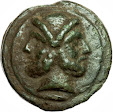Byzantine Trade Weight Group; 7th-10th century AD
A group of four bronze weights each with an incised cross and two
capital letters to one face. Fine condition. I do not have a reference for the symbols on the largest weight. They could be flower decorations or a symbol to identify the person who issued the weights.
From inscriptions, the four weights are:
1.
Quadrans, 3 ounces, Γ· Γ; (81.9 grams std per Bendall1)
2.
Sextans, 2 ounces, Γ Β; (54.6 grams std per Bendall)
3.
Uncia, 1 ounce, Γ A; (27.2 grams std per Bendall)
4. Uncia, 1 ounce, A R; (letters not in Bendall, Hendin2 or Kisch3)
|
#
|
Denomination
|
Weight
Grams
|
Dimension
mm
|
On
Weight
|
|
1
|
Quadrans,
3 ounce
|
73.25
|
34-33-8
LWT
|
Γ· Γ
|
|
2
|
Sextans,
2 ounce
|
45.75
|
30.5-29.5-6.5
LWT
|
Γ Β
|
|
3
|
Uncia,
1 ounce
|
26.53
|
24.5 – dia
7.5 tall
|
Γ A
|
|
4
|
Uncia,
1 ounce
|
27.53
|
22 wide
8.2 tall
|
A R
|
Roman Acorn Weight - Scale or Mason's Plumb Bob?
Roman
Acorn Weight, 1st-3rd century AD – It could be a scale weight or a Mason's
Plumb Bob. A similar weight was found with a steelyard scale by archaeologists
operating in the ancient city of Nea Paphos on Cyprus.4
A
mason's plumb bob weight in the form of an acorn, bronze shell made in two
parts (the acorn cap & nut), details added to the cap, rectangular
suspension loop above; lead core, small tip below. Part of the bronze shell and
lead filling are missing. Someone attempted to remove the cap.
136
grams
52mm tall with 27mm diameter cap and 23mm diameter nut
Fair
condition, part of casing absent.
Provenance
- Property of a Basingstoke, Hampshire, UK, collector; found Hampshire, UK.
1. Byzantine Weights, an Introdudtion by Simon Bendall - the table on pg. 8 lists weights as either commercial or coin. He also breaks weights by time period: Roman to Byzantine. These weights have Γ· which puts them in the commercial Byzantine category.
2. Ancient Scale Weights by David Hendin
3. Scales and Weights by Bruno Kisch
4. A bronze steelyard with an acorn-shaped counterweight from the Paphos Agora, by Maciej Wacławik; Studies in Ancient Art and Civilization 20





